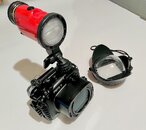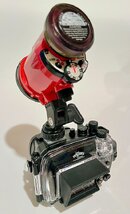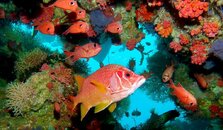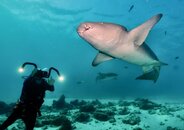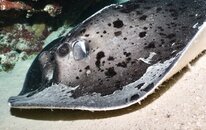Good morning everyone
I should buy my first underwater photography kit and I am very undecided about the camera, or rather the size of the sensor.
I hope someone with more experience can advise me even though I wrote a poem below!
A few premises that I feel it is essential to list :
- Photography fascinates me, but I only know the basics.
- For a short period of time I owned a Sony a6300, with which I had taken my first photography course. To date, however, I have and use only an iPhone (topside).
- Underwater I use a Gopro Hero 5, almost exclusively for video and in ambient light. I think I have squeezed it to the limit, with more than decent results.
- I always edit (basic level) any photo or video to get closer to the results I would like, with all the limitations of the files I get back from the devices I currently own.
- I would like to bring home worthy shots in the dives I do, but the Gopro is unusable for what I have in mind.
- To date, I have never thought of taking photos to print them, only to share them online and then display them on a monitor. This was certainly also because I didn't have sufficient file quality.
- In everyday life (above) I think I would be inclined to use this camera only if it is small.
- I am a technical diver, currently using Rebreather and DPV.
- The type of underwater photography I have in mind is exclusively wide angle at this time. No macro.
- The subjects I most want to capture with my photos are wrecks and people (divers). "Dramatic" photos, playing with lights.
- I mostly dive in lakes with rather poor visibility, or in the seas of northern Italy/Croatia.
- I am not in the habit of taking diving trips to tropical seas.
My plan is to start with camera + aluminum housing, so as to become familiar with the equipment and underwater photography techniques.
Later add Wide lens, strobes or any lights, so as to dilute the expense over time.
I am only considering used equipment and for camera and housing I would like to stay around 2K€.
I discarded full frames solely because of price. I discarded DSLRs and Micro 4:3 because I no longer consider them to be current technologies and I don't feel like investing in them.
With my budget I saw I could either take home a state-of-the-art compact and probably have money left over for other upgrades, or an older and more used APSC+ a lens, having to probably raise the budget I think.
After some online research, I identified the following models :
- Sony RX100 VII (Canon G/X III and Panasonic LX 10/15 should I find a one-time offer).
- Sony a6xxx (a6400 I think might be the sweet spot)
- Nauticam/ Isotta as housing.
It is precisely between compacts and APSCs that lies my doubt : one day I tell myself that a compact (+ wide lens and strobe/ lights) is sufficient and, considering I have no photography experience, it would still give me a sufficient learning curve.
I would also be more inclined to carry it with me all the time for practice and it might give me some nice topside shots as well.
The next day, however, I reconsider and am afraid that after a relatively short time I might find myself in a situation where the 1-inch sensor of a compact already fits me tightly, so I think about APSC.
Thinking about APSCs, I wonder if it makes sense for me right now to invest more in a hobby that I don't know where it will take me, although maybe with an APSC I might not feel the need to do a camera upgrade for a long time.
To close this long monologue, the real question I cannot answer is the following:
Considering the same strobe/light kit and the same wide lens, what are and where are the concrete differences I would see by taking the exact same photo with a compact and with an APSC, displaying them at full resolution on a monitor?
Any advice and thoughts are welcome.
Thank you
N
I should buy my first underwater photography kit and I am very undecided about the camera, or rather the size of the sensor.
I hope someone with more experience can advise me even though I wrote a poem below!
A few premises that I feel it is essential to list :
- Photography fascinates me, but I only know the basics.
- For a short period of time I owned a Sony a6300, with which I had taken my first photography course. To date, however, I have and use only an iPhone (topside).
- Underwater I use a Gopro Hero 5, almost exclusively for video and in ambient light. I think I have squeezed it to the limit, with more than decent results.
- I always edit (basic level) any photo or video to get closer to the results I would like, with all the limitations of the files I get back from the devices I currently own.
- I would like to bring home worthy shots in the dives I do, but the Gopro is unusable for what I have in mind.
- To date, I have never thought of taking photos to print them, only to share them online and then display them on a monitor. This was certainly also because I didn't have sufficient file quality.
- In everyday life (above) I think I would be inclined to use this camera only if it is small.
- I am a technical diver, currently using Rebreather and DPV.
- The type of underwater photography I have in mind is exclusively wide angle at this time. No macro.
- The subjects I most want to capture with my photos are wrecks and people (divers). "Dramatic" photos, playing with lights.
- I mostly dive in lakes with rather poor visibility, or in the seas of northern Italy/Croatia.
- I am not in the habit of taking diving trips to tropical seas.
My plan is to start with camera + aluminum housing, so as to become familiar with the equipment and underwater photography techniques.
Later add Wide lens, strobes or any lights, so as to dilute the expense over time.
I am only considering used equipment and for camera and housing I would like to stay around 2K€.
I discarded full frames solely because of price. I discarded DSLRs and Micro 4:3 because I no longer consider them to be current technologies and I don't feel like investing in them.
With my budget I saw I could either take home a state-of-the-art compact and probably have money left over for other upgrades, or an older and more used APSC+ a lens, having to probably raise the budget I think.
After some online research, I identified the following models :
- Sony RX100 VII (Canon G/X III and Panasonic LX 10/15 should I find a one-time offer).
- Sony a6xxx (a6400 I think might be the sweet spot)
- Nauticam/ Isotta as housing.
It is precisely between compacts and APSCs that lies my doubt : one day I tell myself that a compact (+ wide lens and strobe/ lights) is sufficient and, considering I have no photography experience, it would still give me a sufficient learning curve.
I would also be more inclined to carry it with me all the time for practice and it might give me some nice topside shots as well.
The next day, however, I reconsider and am afraid that after a relatively short time I might find myself in a situation where the 1-inch sensor of a compact already fits me tightly, so I think about APSC.
Thinking about APSCs, I wonder if it makes sense for me right now to invest more in a hobby that I don't know where it will take me, although maybe with an APSC I might not feel the need to do a camera upgrade for a long time.
To close this long monologue, the real question I cannot answer is the following:
Considering the same strobe/light kit and the same wide lens, what are and where are the concrete differences I would see by taking the exact same photo with a compact and with an APSC, displaying them at full resolution on a monitor?
Any advice and thoughts are welcome.
Thank you
N




